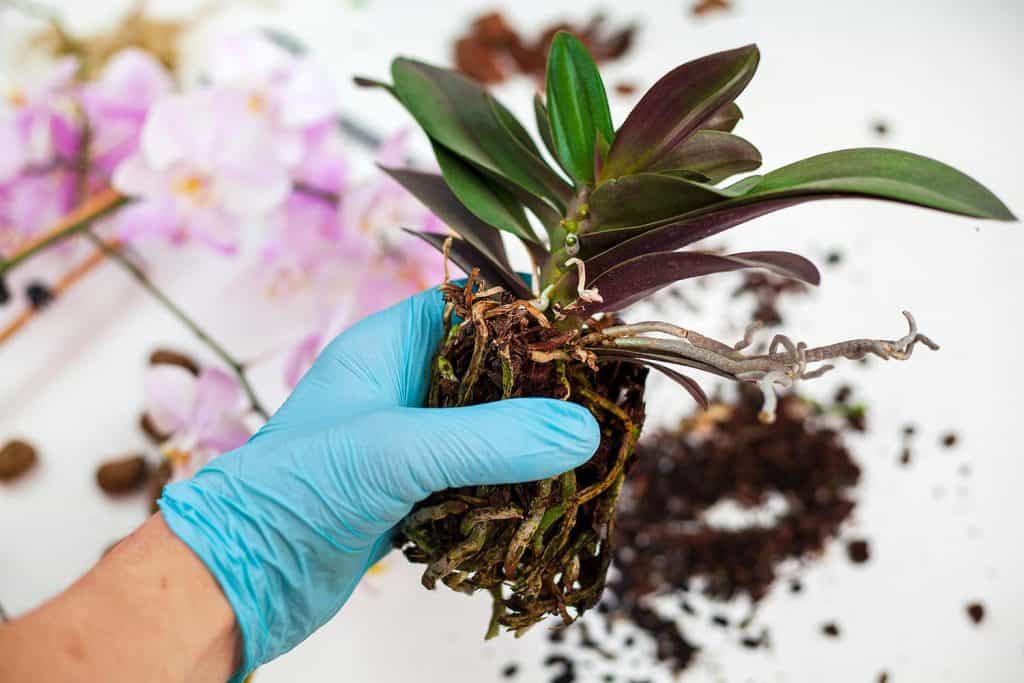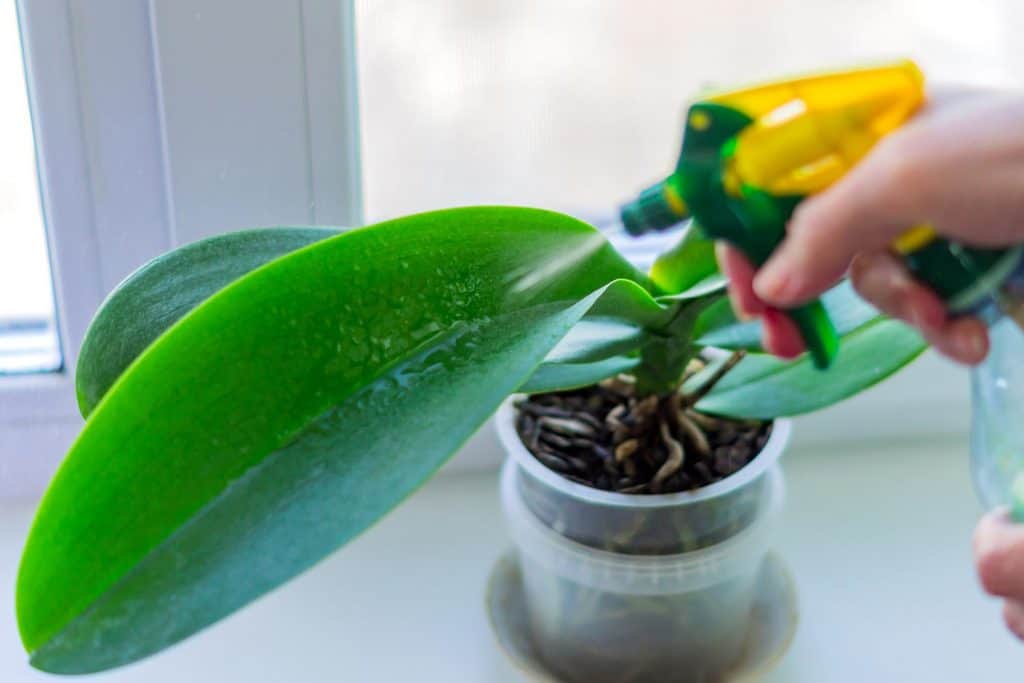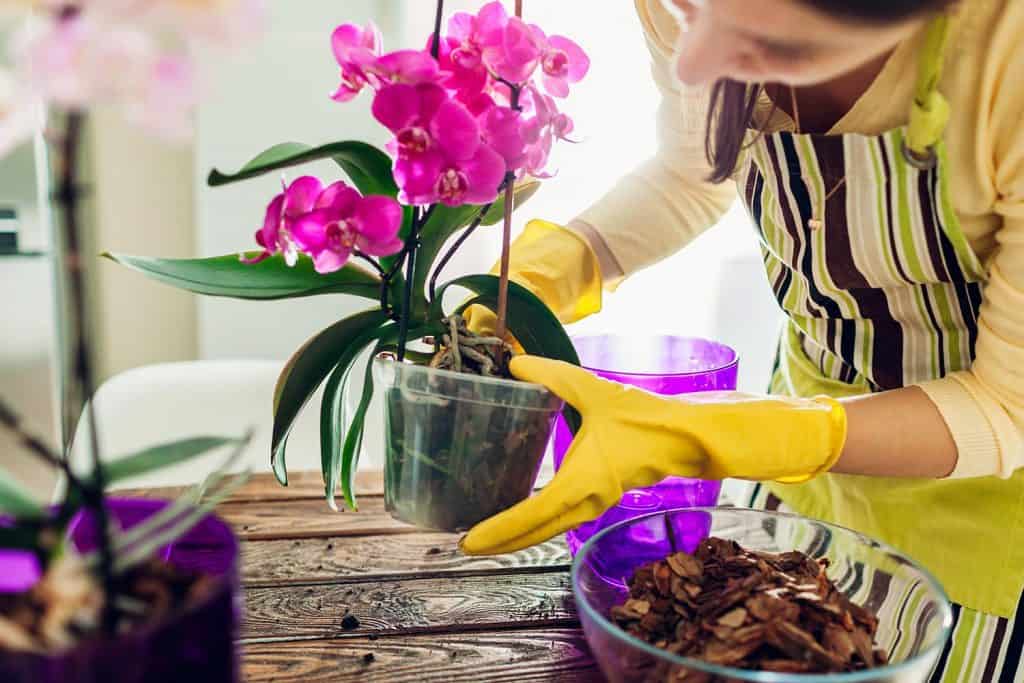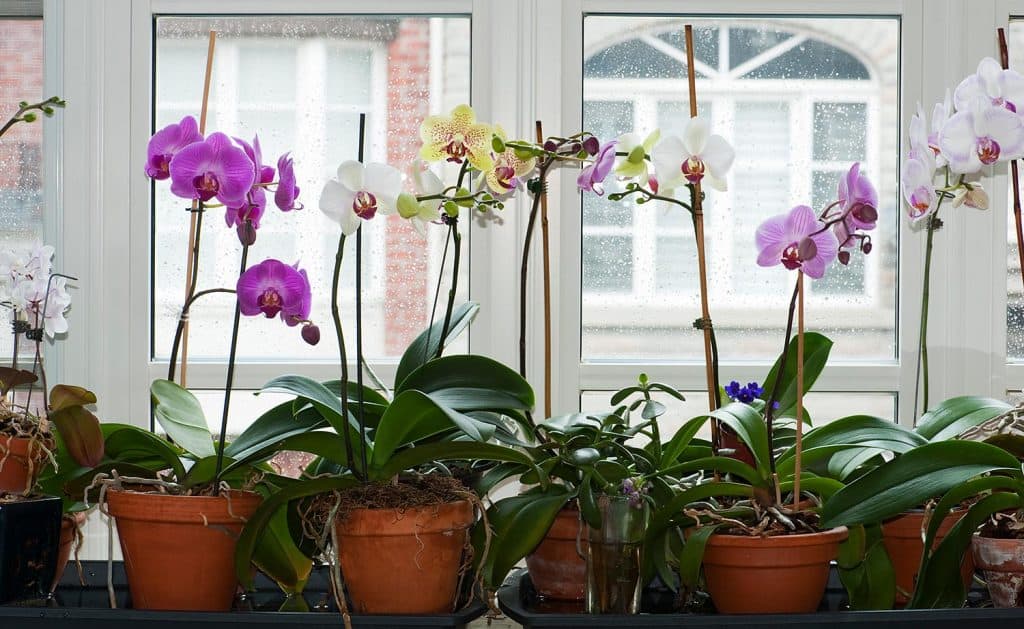The family of Orchids, or Orchidaceae, is a diverse, large selection of flowering plants. If you are a proud owner of one of these fragrant beauties, you know how delicate and sensitive they are. This is why many orchid owners get nervous around repotting or transplanting this flower. Not to worry, we gathered our research to lay out exactly when and how to repot and transplant your orchid for best results. The goal is to keep your flower as happy and healthy as possible.
Orchids should be repotted or transplanted once a year. The best time being just after flowering or when you notice new growth. Other indications that your Orchid is ready to move include closely tangled roots, white roots growing outside the current container, presence of pests, disease, or root rot.
Now you know when to repot your orchid, but do you know how to? Read on as we break down the steps to repotting and transplanting your flower to ensure a successful move.
![A gardener potting of Orchids, When To Repot And Transplant An Orchid [All You Ever Need To Know]](https://gardentabs.com/wp-content/uploads/2021/08/When-To-Repot-And-Transplant-An-Orchid-1-683x1024.png)
How To Repot And Transplant An Orchid
The timing of repotting your orchid is important. You never want to repot during flowering. Right after or before is ideal. You notice your orchid has outgrown its current home and is not flowering; it's time to repot and transplant. Here is how.
1. Choose Your Pot
First, pick out a larger pot for your Orchid. You want the pot you are moving into to be at least 1-2 inches larger than the last. There are pots specially made for orchids, or you can utilize a traditional terracotta pot.
Amazon offers a ceramic Orchid pot here.
2. Prepare Your Soil and Planting Medium
Before moving your plant, your Orchid potting soil needs to be prepared. Place your soil into a large bowl with boiling water. Allow the bowl to sit until cool, and then drain your soil. This will sterilize your mix and create a damp environment to get your Orchid settled.
You can find an all-natural Orchid planting mix here on Amazon.
Maybe you plan to use a planting medium outside a commercial potting mix. Many growers utilize peat moss, bark, or perlite. What medium is best for your flower depends on what type of Orchid you have. Knowing your species needs can help you create a personalized growing mix.
3. Wash Everything
Orchids are gorgeous and particularly sensitive, especially to germs. Sterilization of your soil mix is recommended, and it is the same with your pots, garden tools, and hands.

To sterilize your chosen pot and tools, let them soak in a bleach mixture. Mix 1/4cup of bleach to one gallon of water and allow these items to soak overnight. When it is time to handle your orchid, wash your hands thoroughly or throw on a pair of gloves.
4. Prepare Your Orchid
Now that all your equipment is ready to go, time to get your hands on your Orchid. You will remove your plant from its current home very gently. Take your time washing off the roots and removing any pieces that look unhealthy or dead with a pair of scissors.
5. Place Your Orchid In Their New Home
Fill your new planter with your damp potting medium. The Orchid will be placed on top, so the base of the plant sits right on top of your potting mix or medium. Gently push pieces of the medium around your flower's roots. Finish up the process with a light mist.
The video below gives you a detailed visual of the steps of repotting your Orchid.
Should I Water Orchids After Repotting?
Yes, you should water your orchid after repotting. Once your plant is settled in its new home, give a thorough watering and not water again for 1-2 weeks. A break in watering promotes new root growth.

During this break, ensure your plant is in a humid environment. You can give a light mist to increase humidity and allow slightly less sunlight during the first week after repotting.
How Do You Repot A Store-bought Orchid?
When you pick up an orchid from a grocery store, they are typically housed in a plastic container, sat in a ceramic pot with no drainage. The roots are bundled in sphagnum moss to keep moisture in without too much need for watering.
Your Orchid will not be happy in this environment for much longer. The excessive moisture will eventually lead to root rot and death, or at least damage to any healthy roots. The need to repot is there, so how do you do it? You use the same steps we discussed above. There really is no difference. Once the flowers of the Orchid are past their prime, you follow the steps to repotting you'd use for any of your orchids.
The video below goes into more detail surrounding store-bought orchids:
What Kind Of Soil Do You Use To Transplant An Orchid?
Fresh, new potting soil is what you use to transplant an orchid. Never reuse soil or potting material. Reusing materials opens the door to decreased drainage, increased moisture, and ultimately fungal or bacterial issues.
There are plenty of commercial orchid soils available for purchase, or you can create your own growing medium. Have a look at the video below for some of these DIY orchid potting mixes:
Learn more on our blog post: Which Soil Is Best For Terrance/Patio Garden?
What Is The Best Potting Mix For Orchids?
Commercial potting mixes for orchids come in various brands and make-ups. There are specie specific potting mixes, all-purpose orchid mixes, all-natural potting soils, and more. Some of the top brands we found include the following:
- Repotme All Purpose Orchid Mix
- Better-Gro Special Orchid Mix
- Orchiata Bark Classic
Each mix has its pros and cons. Let's take a closer look at each.
Repotme All Purpose Orchid Mix
This soil-free potting mix offers maximum water retention and airflow. Great for all types and ages of orchids. Be careful of the pH when using this mix. With some flowers, the acidity levels can be too much.
You can find this high-quality potting mix here on Amazon.
Better-Gro Special Orchid Mix
Beginner orchid owners and professional gardeners have used this special orchid mix. You will find a combination of fir bark, hardwood charcoal, and sponge rock inside.
Amazon offers this multi-purpose Orchid mix here.
Orchid Bark Classic
This Orchid bark promotes healthy roots and is ideal to use when repotting. This potting mix allows for optimal drainage and comes in reusable packaging.
Find this New Zealand bark for Orchids here on Amazon.
When Should You Split And Repot An Orchid?
Splitting is a way to propagate your orchid. Some species split better than others, and all orchids have their ideal time to split and repot. Splitting and repotting should never be done when your plant is flowering. You want to complete these processes when your orchid is sending out fresh roots. Orchids should be split and repot either at the start of new growth or immediately before it.

The idea is to give your plant time to establish before the next blooming period.
Do Orchids Need Bigger Pots?
Larger pots allow plants to increase growth, giving room for more leaves, flowers, and roots. The majority of Orchids start in 4-6 inch pots. When repotting and transplanting your Orchid, you will need a bigger pot.

A good rule of thumb when going up a size in pots is, pick a pot that is 1 inch (2.54 cm) larger in diameter. You can get away with using the same size pot for up to two years with orchids, but then you will need to upsize to keep up with its roots.
Read more on our blog post: Type Of Planters And Planting Pots
In Summary
Orchids need to be repotted and transplanted at least once a year. This plant may show you signs that it is ready to be transplanted sooner. Look out for tangled roots or white roots coming out of your current pot. By following the steps discussed, you will be able to successfully transplant your orchid into a new pot allowing for thriving growth and optimal happiness. We hope you found this article helpful when caring for your orchid and insightful regarding their soil, pots, and transplant needs.
Are you looking to add more flowers to your space? Have a look through our blog post, 35 Stunning Pink Flowers For Your Garden.





